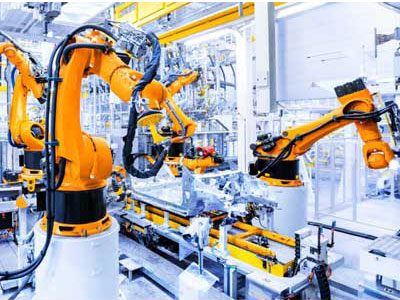Key Takeaway
Industrial robots have a vast scope in manufacturing applications. They handle tasks like welding, painting, assembling, and moving components efficiently. These robots improve precision and speed, reducing human error and labor costs. They are used in various industries, from automotive to electronics, enhancing production quality and safety. With advancements in AI and machine learning, industrial robots are becoming smarter and more versatile, capable of performing complex tasks and adapting to new challenges. Their role is crucial in modern manufacturing, driving innovation and productivity.
Current Applications
Industrial robots are revolutionizing many sectors by performing tasks with speed and precision. In manufacturing, they handle repetitive tasks such as assembly, welding, painting, and packaging, significantly increasing productivity and reducing labor costs. In automotive industries, robots are crucial for assembling cars and ensuring precision in welding and painting. Additionally, in electronics, robots manage the intricate task of assembling tiny components, improving efficiency and product quality. Food and beverage sectors also benefit, as robots handle packaging and palletizing, maintaining hygiene and reducing waste. These current applications underscore the versatility and indispensability of industrial robots in enhancing production processes.

Emerging Industries
The scope of industrial robots is rapidly expanding beyond traditional manufacturing sectors, reaching into emerging industries with significant impact. In agriculture, robots are transforming farming practices by taking on tasks like planting, harvesting, and monitoring crops. This not only boosts productivity but also cuts down on labor costs. Imagine the precision and efficiency of robots ensuring each plant gets the perfect amount of care. In logistics and warehousing, the rise of e-commerce is driving the adoption of robots for sorting, packing, and transporting goods. These robots streamline operations, meeting the high demands of fast-paced industries.
In the healthcare sector, robotic applications are surging. Surgical robots perform minimally invasive procedures with remarkable precision, reducing recovery times for patients. Robots are also assisting in patient care and rehabilitation, offering support and improving outcomes. This versatility of industrial robots in diverse fields demonstrates their potential to revolutionize various sectors. The expansion into these emerging industries highlights how industrial robots can tackle new challenges and improve efficiency, showcasing their adaptability and broadening their impact.
Technological Innovations
Technological innovations are continuously enhancing the capabilities of industrial robots, making them smarter and more efficient. Artificial Intelligence (AI) and machine learning algorithms enable robots to learn from their environment and improve their performance over time. This means robots are becoming more adept at handling complex tasks and adapting to new situations. Advanced sensors and vision systems give robots the ability to navigate intricate environments and perform precise operations, ensuring high accuracy in their tasks.
Collaborative robots, or cobots, are another exciting development. Designed to work alongside humans, cobots increase workplace flexibility and safety. They can assist with tasks that require human judgment while handling repetitive or dangerous jobs. Additionally, advancements in robotics software are simplifying the process of programming and integrating robots into existing systems. This reduces the barrier to adoption for many businesses, making it easier for companies to implement robotic solutions. These technological innovations are driving the evolution of industrial robots, expanding their capabilities and applications.
Global Market Trends
The global market for industrial robots is experiencing robust growth, driven by strong demand across various regions. Asia-Pacific, particularly China, Japan, and South Korea, leads in robot adoption due to their strong manufacturing sectors and substantial government support. These countries are setting the pace with significant investments in automation and robotics. Europe and North America are also major markets, with industries like automotive, electronics, and food and beverage driving demand. The need for automation is becoming more pronounced as labor costs rise and efficiency demands increase.
The COVID-19 pandemic has further accelerated the adoption of robots to maintain production and ensure worker safety. Robots are being deployed to fill labor gaps and maintain operations during disruptions. This trend is contributing to the rapid growth of the global robotics market. As more industries recognize the benefits of automation, the demand for industrial robots continues to surge. This robust market growth underscores the vital role of robots in enhancing productivity and operational efficiency across the globe.
Future Prospects
The future prospects for industrial robots are promising, with ongoing technological advancements and increasing adoption across various industries. Robots are expected to become more intelligent, autonomous, and capable of performing a broader range of tasks. The integration of robots with IoT devices and cloud computing will enable real-time monitoring and data analysis, enhancing operational efficiency. This connectivity will allow robots to operate more seamlessly and provide valuable insights to optimize processes.
As robots become more affordable and accessible, small and medium-sized enterprises (SMEs) will increasingly adopt robotic solutions. This democratization of technology will enable businesses of all sizes to benefit from automation. Additionally, the development of new materials and energy-efficient designs will enhance the sustainability and cost-effectiveness of robots. These advancements will make robots not only more capable but also more environmentally friendly. The future of industrial robots is bright, with endless possibilities for innovation and application in various sectors, promising significant improvements in productivity and efficiency.
Conclusion
Industrial robots are set to revolutionize manufacturing with their precision, efficiency, and versatility. As technology advances, their scope extends beyond assembly lines to include complex tasks like welding, painting, and even collaborative operations with humans. With increased automation demands and evolving AI capabilities, industrial robots promise enhanced productivity and safety across various sectors. Embracing this technology ensures businesses stay competitive and adaptable in the rapidly changing industrial landscape.
